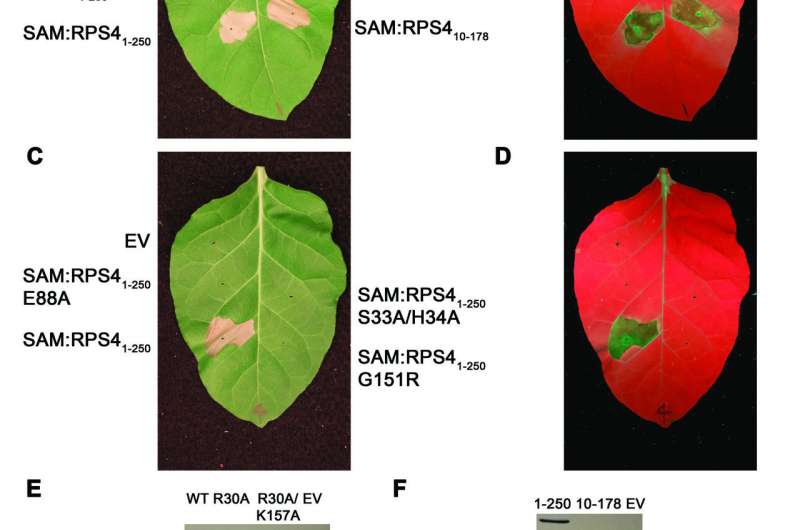Experiments illuminate key component of plants' immune systems

Plants, like humans and animals, have over millions of years evolved complex immune systems that fend off invading pathogens. But unlike many animals, plants lack adaptive immunity conferred by antibodies. This means each plant cell must defend itself against all potential pathogens—a daunting task.
Hiding inside each plant cell, protein complexes encoded by disease resistance genes are like sleeping armies, waking up and activating defenses when harmful pathogens such as fungi or bacteria are detected. Such genes encode traits used by agricultural biotechnologists to generate disease-resistant crops, and plant biologists are striving to illuminate every aspect of how they work—much of which remains shrouded in mystery.
In new research published in the journal Science, a team of biologists, including Colorado State University Assistant Professor of Biology Marc Nishimura, have shed new light on a crucial aspect of the plant immune response. Their discovery, revealing how plant resistance proteins trigger localized cell death, could lead to new strategies for engineering disease resistance in next-generation crops.
The research team was led by Nishimura, Jeff Dangl of the University of North Carolina at Chapel Hill, and Jeffrey Milbrandt of the Washington University School of Medicine. Nishimura started the work as a research scientist in the lab of Erin Osborne Nishimura, CSU assistant professor in the Department of Biochemistry and Molecular Biology.
Together with colleagues, Nishimura identified the mechanism of one little-understood domain of plant resistance proteins called a "toll-interleukin-1 receptor," or TIR domain. The team showed that during the plant immune response, the TIR domain is an enzyme that degrades a molecule called NAD+, which is essential for metabolism in all organisms. By cleaving NAD+, the plant self-destructs infected cells while leaving others unharmed.
Scientists had previously surmised that plant TIR domains might act like physical scaffolds, building a structure that attaches to the cell's plasma membrane and recruiting other proteins to the area to begin an immune response. This is how these domains work in animal cells, including in humans.
But in 2017, Nishimura's collaborators at Washington University School of Medicine observed an unusual animal TIR domain, found in a protein called SARM1, that doesn't work like other TIR signaling scaffolds in animal cells. Rather, it functions as an enzyme. Nishimura and colleagues set out to probe whether this domain could have a similar function in plant immunity.
Nishimura and colleagues' new work in Science shows that the role of TIR domains in the plant immune response is indeed functionally related to the role of the more unusual animal TIR domain in SARM1. They found that the plant TIR domain is itself an enzyme that cleaves NAD+, rather than acting as a structural scaffold that recruits other components. But there was an important difference. While the animal TIR domain in SARM1 kills cells by depleting NAD+ levels, plant TIR domains instead appear to cleave NAD+ to generate a signaling molecule. This molecule—not seen in animal cells—is structurally related to a classical signaling molecule called cyclic ADP-Ribose. The team is now working to understand how this new product they saw influences cell death and disease resistance.
"For 25 years, we didn't know what TIR domains did in plants," Nishimura said. "So these results were very interesting in terms of advancing our understanding of how TIR domains actually trigger immunity."
Uncovering individual biochemical pathways in the plant immune response may be crucially important to how plant systems are manipulated to protect food crops, particularly as new pathogens emerge and global food supplies become vulnerable, Nishimura said.
"Hopefully, really mechanistically understanding immune receptors will help us transfer existing receptors while retaining function, and ultimately let us rationally engineer new receptors to recognize emerging pathogens," he said.
More information: "TIR domains of plant immune receptors are NAD+-cleaving enzymes that promote cell death" Science (2019). science.sciencemag.org/cgi/doi … 1126/science.aax1771
Journal information: Science
Provided by Colorado State University




















